|
When I was teaching embroidery in China last year, I saw so many beautifully embroidered items. Far too many to put into one blog post. Today we will explore a very distinctive form of embroidered items: rank badges. Those square pieces of densily embroidered cloth that were sewn onto the formal dress of Qing-dynasty (1644-1911 AD) court officials. The Qing emperors were the last house to rule China. They were not native Chinese, but rather a nomadic minority from Manchuria. Due to a power vacuum in the middle of the 17th century they were able to take over the dragon throne. Native Chinese viewed these newcomers as barbarians. Vice versa, the Manchu viewed the Chinese as too refined. Discrimination and mistrust were the result. In an attempt to at least minimize discrimination amongst the court officials and to legitimize their new dynasty, court dress was completely renewed by the new emperor. Modelled on Manchu dress, but with strict rules on who could wear what and when. As the imperial administration became ever more complex, it was necessary to be able to easily distinguish people's place or rank in the system. There were nine ranks of civil officials all sporting a different bird on their rank badge. From first to ninth rank these were: Manchurian crane, golden pheasant, peacock, wild goose, silver pheasant, egret, mandarin duck, quail and paradise flycatcher. The badges (called pu zi) were sewn onto the surcoat pu fu, or 'coat with a patch' and worn over the formal court robes. The badges would be sewn onto the front as well as onto the back. That's why a pair always consists of a 'whole' one for the back and a 'split' one for the front. Why did they use birds to differentiate between civil officials? As always, everything depicted has more than one meaning for the Chinese. Birds collectively were seen as a symbol of literary elegance. Additionally, the crane was associated with happiness and longevity. The wild goose and the mandarin duck represented loyalty; not an unimportant quality for a court official. Military officials wore rank badges too. Instead of birds, animals associated with courage and ferocity adorn these badges. Again there are nine ranks and from first to ninth rank these are the animals depicted: qi lin (a mythical creature with the head of a dragon, scales on his body, the legs of a stag and a bushy tail), lion, leopard, tiger, bear, panther, rhinoceros and sea-horse. Lower ranks of the imperial nobility were also permitted to wear the military rank badges. The wives of military and civil officials adorned their formal dress with rank badges too. Rather than being part of the court, they would wear their dress with badges during important social occasions such as marriages. Besides his official empress, the emperor had many secondary consorts and concubines. They were ranked as well. And with so many potential partners, he had many offspring too. The emperor, his sons, first-rank princes, second-rank princes, third-rank princes, fourth-rank princes, imperial dukes and other non-imperial nobles wore round rank-badges displaying dragons. The number of dragons you could wear depended on your rank. As did the type of dragon you were permitted to wear: front-facing dragons were higher in rank than side-facing dragons. And five-clawed dragons (long) were higher in rank than four-clawed dragons (mang).
If you have enjoyed reading about official court dress, I can highly recommend the book 'Imperial Wardrobe' by Gary Dickinson and Linda Wrigglesworth (2000, ISBN: 1-58008-188-6) for further reading. This is the revised edition of an original from 1990.
16 Comments
Chris McClernan
14/1/2019 15:13:48
I really enjoy the historical information in your blogs, as well as your beautiful stitching when that is shown. I look forward to seeing what you will tell us about every week. Thank you!
Reply
14/1/2019 17:29:45
Thank you for the compliments Chris! I really enjoy writing these posts as I learn a lot from my research too. With the rank badges there was not really any informytion on display in the museum. Luckily I have quite a nice library. Looking through my pictures and reading up on the topic means my trip memories last way longer too!
Reply
14/1/2019 19:30:12
LOL, I can just see inexperienced youngsters sneak up to seasoned court officials to count the number of claws on their dragons :).
Reply
Thanks Jessica for such impressive information. I personally know nothing about this ancient oriental History.
Reply
14/1/2019 19:31:50
You are very welcome Meri! I especially love how symbols have multiple layers of meaning. And the design and embroidery is just fantastic.
Reply
Marina Berts
15/1/2019 07:46:01
How exciting! Thank you for your article and research. I suppose everything was stitched with silks? Or did they use cotton threads at all? We're you able to see what traditional stitches were used? Did they have metal threads like our Japanese thread (lol) or Tambor, or such threads as Bright check? You've made lovely pictures, congrats - it's so difficult to take pictures in a museum.
Reply
15/1/2019 11:52:25
Thank you Marina! Yes, it is all stitched in silk on a black silk background. Stitches used include Chinese knots and satin stitch. And couching with what we would call Japanese thread. They don't use purls and the refer to that as European goldwork.
Reply
15/1/2019 11:55:17
Thank you Catherine! Yes it was indeed a great adventure and I can really recommend going there and visit the National Silk Museum.
Reply
Joyce Bargh
15/1/2019 12:58:17
Is the scales on the dragon couched? I have seen it on other pieces of Chinese embroidery done in gold in basket weave but this looks to be couched in semi-circles?
Reply
15/1/2019 17:43:17
That's right Joyce; pairs of goldthread are couched in semi-circles and partly overlapping each other. Very convincing as dragon scales!
Reply
26/1/2019 16:46:16
Hi Sue! The whole piece is stitched with Chinese knots. To imitate the idea of fur, straight stitches were placed on the outline of the leopard.
Reply
Lisa Mueller
18/11/2023 17:44:38
I have a Silver Pheasant Civil Badge 9th rank. Friendly purple walrus. A collector wants to buy it from me for $150. I don’t know enough about it just yet, I keep telling him. He sure is persistent!
Reply
Your comment will be posted after it is approved.
Leave a Reply. |
Want to keep up with my embroidery adventures? Sign up for my weekly Newsletter to get notified of new blogs, courses and workshops!
Liked my blog? Please consider making a donation or becoming a Patron so that I can keep up the good work and my blog ad-free!
Categories
All
Archives
July 2024
|
Contact: info(at)jessicagrimm.com
Copyright Dr Jessica M. Grimm - Mandlweg 3, 82488 Ettal, Deutschland - +49(0)8822 2782219 (Monday, Tuesday, Friday & Saturday 9.00-17.00 CET)
Impressum - Legal Notice - Datenschutzerklärung - Privacy Policy - Webshop ABG - Widerrufsrecht - Disclaimer
Copyright Dr Jessica M. Grimm - Mandlweg 3, 82488 Ettal, Deutschland - +49(0)8822 2782219 (Monday, Tuesday, Friday & Saturday 9.00-17.00 CET)
Impressum - Legal Notice - Datenschutzerklärung - Privacy Policy - Webshop ABG - Widerrufsrecht - Disclaimer






 RSS Feed
RSS Feed